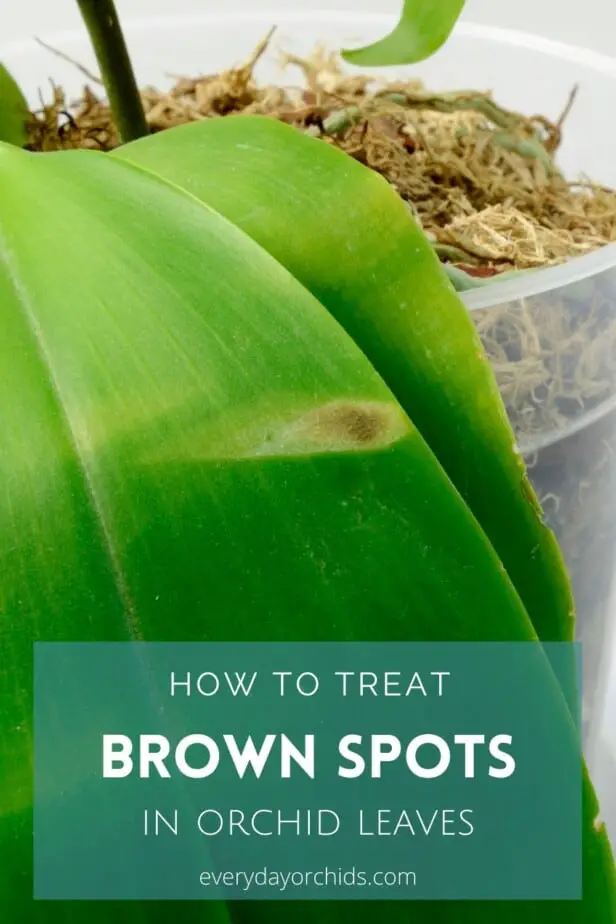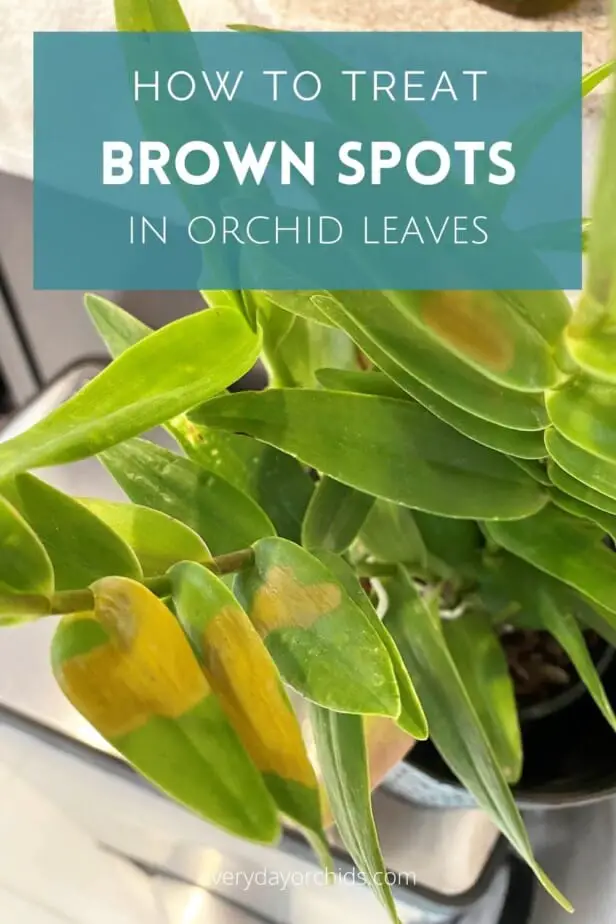If you are wondering how to treat brown spots on your orchid’s leaves, you’ve come to the right place. Brown spots on orchid leaves are a worrisome problem, and in some cases, you will need to act quickly to save your orchid.
To treat brown spots on orchid leaves, you will need to cut off all the infected leaves and orchid parts that have brown spots. Sterilize the blade between each cut. Then, treat the orchid with a fungicide. Keep it separate from your other orchids and plants until you are certain the infection has been eradicated.

There are actually two types of bacteria which can infect your orchid and lead to brown spots on the leaves. However, the basic treatment method is similar for both types of infection.
I will go over what causes brown spots on orchid leaves and what to do when you find brown spots on your orchid leaves. You’ll also learn how to prevent it from happening again. Keep reading to learn more.
Please note that these links are affiliate links and as an Amazon Associate, I earn from qualifying purchases. Purchases made through affiliate links in this post may generate commissions at no additional cost to you. Use this link for a discounted Amazon Prime trial. Thank you for your support!
Table of Contents
What Causes Brown Spots on Orchid Leaves?
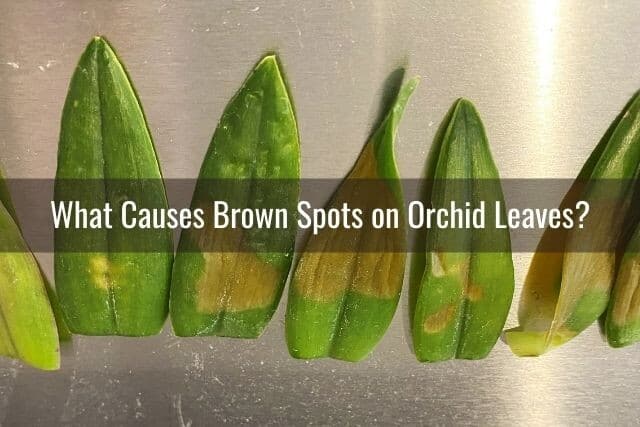
Oftentimes, brown spots on orchid leaves are caused by a bacterial infection. There are actually two types of bacteria that can cause brown spots to appear in orchid leaves, leading to two different types of leaf rot.
Infection is one of the reasons why orchid leaves change color. In fact, infection is one of the top problems orchid growers will encounter. I will talk about both types of infection in this article.
One bacteria that causes brown spots in orchid leaves is Pectobacterium carotovorum, or Erwinia. It is an organism that causes destruction of the plant’s cell wall. High humidity and heavy rainfall can lead to the spread of this bacteria.
Contaminated irrigation water, tools, potting media, or insects carrying the bacteria can also spread Pectobacterium carotovorum among plants. This bacterial infection can affect orchids and many other plants, causing bacterial brown spot and soft rot.
The other bacteria that causes brown spots to appear on orchid leaves is Acidovorax avenae, or Pseudomonas. Acidovorax avenae causes bacterial brown spot in orchids.
Warm conditions with high levels of humidity encourage the growth and spread of Acidovorax avenae. This bacteria is found in the exudate, or drainage, from infected orchid leaves. It spreads from orchid to orchid through splashing water. Infected plants in close proximity can also spread the bacteria.
What Are The Signs of Bacterial Brown Rot in Orchids?
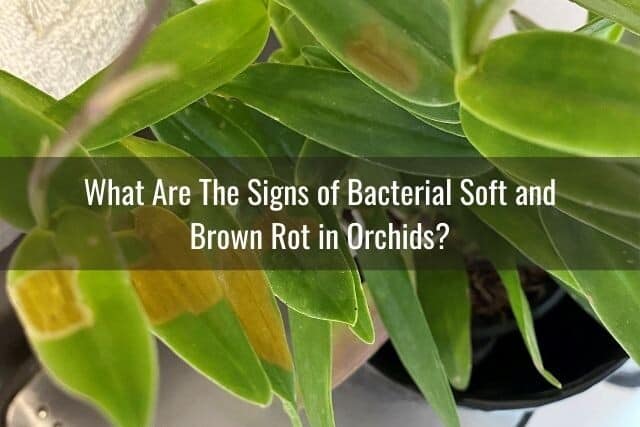
First, let’s talk about the type of infection caused by the microorganism Pectobacterium carotovorum.
Bacterial brown rot is caused by Pectobacterium carotovorum, or Erwinia. It is usually first seen on an orchid leaf as a small, soft, water-soaked spot. The wet spot on the leaf starts out small, but can quickly grow in size and turn brown.
A yellow halo will surround the brown spot as it grows in size and can take over the entire leaf. You can see this pictured above in my Epidendrum orchid, which unfortunately, developed bacterial brown spot.
The wet spot will have a foul-smelling odor. Once the brown rot takes over the orchid leaf, the orchid leaf becomes soft, brown and slimy.
If there are any wounds or open areas on the orchid plant, Pectobacterium carotovorum, or Erwinia, can enter and infect the plant. It is an opportunistic bacteria.
Bacterial soft and brown rot tends to progress quickly in orchids, especially Phalaenopsis orchids. Within 1 to 2 days, the entire leaf might become affected.
If left untreated, the brown rot will continue to spread to the rest of the orchid. Within a few days, the entire plant will be infected with this bacteria.
In orchids with pseudobulbs, bacterial soft and brown rot, if left unchecked, can slowly spread to infect the rhizomes and pseduobulbs. Over time, the brown rot will continue to spread and infect the entire orchid.
What Are The Signs of Bacterial Brown Spot in Orchids?
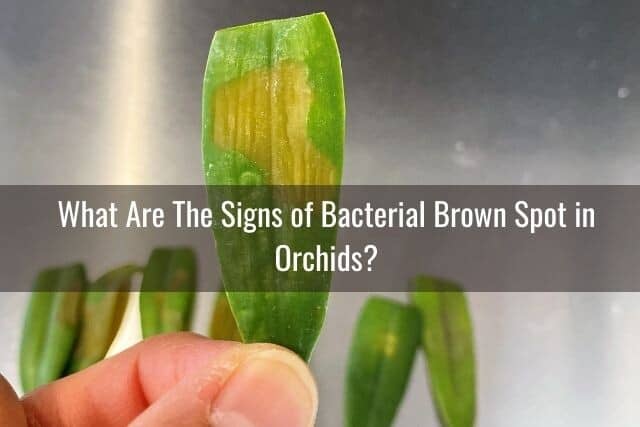
The other bacterial infection we will talk about is brown spot, not to be confused with brown rot which was discussed above. Bacterial brown spot is caused by Acidovorax avenae, or Pseudomonas.
Similar to brown rot, bacterial brown spot starts off as a soft, watery lesion on the orchid’s leaf. Initially, the watery lesion will be light yellow or green in color. As time goes on, this watery lesion becomes larger, sunken, and turns brown or black.
In the advanced stages of bacterial brown spot, the infected lesions on the orchid leaf release a dark, foul-smelling liquid. You will notice more exudate, or infected fluid, on the leaf when the lesion reaches the leaf tip.
Bacterial brown spot can affect many different types of orchids, but Phalaenopsis orchids are highly susceptible to this infection. This bacterial infection can quickly kill off a Phalaenopsis orchid within days and must be treated immediately.
In other orchids, however, such as Cattleya orchids, the infection spreads more slowly and is not life-threatening. Brown spot in Cattleya orchids is typically limited to the older leaves, producing pronounced black spots on the leaves. Infection is one of the reasons why you may see orchid leaves change color.
How to Treat Brown Spots in Orchids
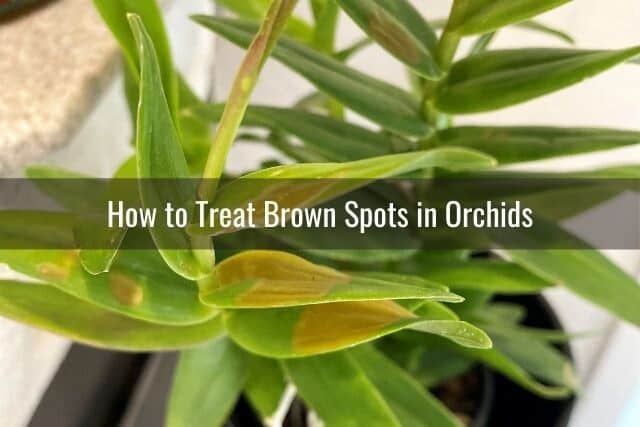
As you now know, brown spots on orchid leaves can be due to either bacterial brown rot or brown spot. These infections are caused by two different organisms. However, the treatment for both types of infections is similar. I will go over the treatment steps below.
Isolate Your Orchid Plant
As a general rule of thumb, as soon as you notice any new infection or infestation in your orchid plant, the very first thing you should do is isolate the infected orchid from the rest of your plants. This holds true here. As soon as you realize something is wrong with your orchid, separate it from your other plants and put it into quarantine.
Both bacterial brown rot and bacterial brown spot are highly contagious. Check over your other orchids and neighboring plants to see if they are also affected. If they are, isolate and treat them as well.
Trim Off Any and All Orchid Leaves With Brown Spots
Brown spots or brown rot on orchid leaves are strong indicators of a bacterial infection. This infection can spread quickly to the rest of the plant if left untreated.
After isolating your affected orchid, the next thing you need to do is get a pair of sterilized scissors, razor blade or gardening shears.
Using a sterilized blade, cut off all the affected leaves with brown spots. If the infection has spread to other parts of the orchid, be sure to remove those too. Along with the rot, cut off some of the healthy tissue found below the infected areas as well. This is to ensure that you remove all compromised tissue.
Sterilize or disinfect the blade between cuts. This is important to prevent the spread of the bacteria to other parts of the plant.
It might be helpful to have two different sets of gardening shears, scissors or blades available. That way, you can cut with one blade while the other one is being sterilized and disinfected in a 10% bleach solution. Then you can switch to the sterilized blade and let the used blade soak and become disinfected.
Another way to sterilize the blade is to use 70% isopropyl alcohol to disinfect the blade between use. You can also use a flame to sterilize the blade between cuts. It may go without saying, but choose one method and stick with it. Don’t mix an open flame with bleach or isopropyl alcohol.
Dispose of infected leaves and orchid parts in a bag. Seal it and toss it in the trash. When you are done trimming off all the infected orchid parts, be sure you sterilize your blade one more time before putting it away.
Treat Cut Ends With Cinnamon
If you have read my other articles, you know that I am a big fan of using ground cinnamon powder for orchids. Ground cinnamon powder has anti-fungal properties. Ground cinnamon also has a drying effect, further helping seal off the open area.
I usually dab a small amount of ground cinnamon powder onto cut leaves, stems, and root ends to help seal off the open wounds and prevent further infection or re-infection.
Treat The Orchid and Its Neighbors
Now that you’ve removed the infected leaves and orchid parts, you’ll want to follow up with a fungicide. This will ensure that you remove any microscopic bacteria that you may have missed and will help prevent reinfection. When it comes to fungicides, you have a couple of options: Physan20 or copper fungicide.
Physan20
Use a liquid fungicide such as Physan20 to treat your infected orchid. Physan 20 works as a disinfectant, fungicide, algaecide and virucide. This will help control and kill pathogens that might be transferred from contaminated tools, potting media, or pots.
To use this, prepare the Physan according to the package directions. For use on orchids, dilute 2 teaspoons of Physan in 1 gallon of water. Spray the orchid early in the morning and do not water it or get it wet after treatment. Otherwise, you risk washing off the fungicide.
Copper Fungicide
Alternatively, you can use a copper fungicide to treat the infected orchid. To use, mix this product with water and apply it using a spray bottle. Again, you want to apply the treatment early in the morning and do not water the orchid afterwards, to avoid washing off the fungicide.
Besides brown rot, copper fungicide can be used to treat powdery mildew, black spot, and other diseases on orchids. You can also use copper fungicide on many other plants.
Be aware that copper fungicide can irritate the skin, even when diluted, so be sure to wear gloves and long sleeves before handling the product. Follow the product directions carefully to find the right dilution ratio. Also note: Copper products should not be used on Dendrobium orchids or orchids in bloom.
Treat Neighboring Plants
Whether you choose to use Physan or copper fungicide on your infected orchid, it is a good idea to also spray down and treat the neighboring plants. Remember, these bacterial infections are highly contagious and can spread easily between plants. By treating the orchids and plants that were next to the infected orchid, you can be sure that you have stopped the outbreak from further spreading.
Continue to Keep the Orchid Isolated
Even after you have treated the orchid’s infection and removed all the leaves with brown spots, keep the orchid isolated for a while longer. You want to make sure that you didn’t miss anything and that the infection was completely eliminated before you introduce your orchid plant back into your collection.
Keep your orchid separate from your other plants for another week or two. Monitor it carefully to see if you can spot any other pests or infections spreading throughout your orchid plant. Deal with these as they come up. Once you are sure that your orchid is free of disease or pests, then you can place it with your other orchids.
How to Prevent Brown Spots from Coming Back To Your Orchid

As you can see, treating infections in an orchid can be time-consuming and a hassle. It’s better not to have an infection in the first place, right? Well, fortunately there are some steps you can take to keep your orchids healthy and prevent infection and rot from occurring.
Bacterial brown rot and brown spot are orchid infections that are easily preventable. Here are some simple interventions you can take to improve the health of your orchids and prevent infection.
Manage Humidity Levels
Warm, moist growing conditions contributes to the spread of bacterial brown rot. If high humidity levels were contributing to your orchid problems, then you will need to reduce humidity levels around your orchid. You can monitor humidity levels using a hygrometer such as this hygrometer.
Most orchids do well with humidity levels ranging from 40-70%. However, certain orchid species will prefer a lower humidity level, while others require high humidity. Get to know your orchid and find out what kind of orchid you have, as well as what its growing requirements are.
Increase Airflow
Move your orchid to an area with better air circulation. Proper airflow will help manage humidity levels and prevent bacterial rot, mold growth, and other orchid problems from occurring.
Avoid placing your orchids too close together. Maintain space between different orchid plants to allow for airflow between the leaves and pots. Allowing for space between orchids will also make it more difficult for pests and infectious organisms (bacteria) from easily moving from one orchid to another. You can also use a circulating fan in your orchid’s growing room to help maintain airflow.
In addition, good air circulation helps promote drying of the potting media after watering. This, in turn, prevents other orchid problems such as root rot, mold and accelerated decomposition of the potting media.
Regulate Temperature
Providing the proper temperature range for your orchid will help it thrive and reduce environmental stress on the plant. Most orchids prefer temperatures between 65 to 80 degrees Fahrenheit during the day, with a 10 to 20 degree temperature drop at nighttime to encourage blooming.
Maintaining the proper temperature for your orchid will keep it healthy and help it fight off any infections or disease. Again, you can monitor the temperature of your orchid’s growing area with a hygrometer. I’ve used this hygrometer for years and would recommend it. It monitors both temperature and humidity levels and tracks the 24-hour highs and lows.
Water The Roots, Not The Leaves
One key rule of orchid care is to water the orchid roots only. I cover this in my Everyday Orchids guide on how to water orchids.
Avoid watering the orchid from overhead, as water can splash on the leaves. Overhead watering can also result in water pooling and sitting in the orchid’s crown. Left alone, this standing water can lead to crown rot in the orchid.
So water the roots, not the leaves. This may seem like a no-brainer to you, but you would be surprised at how often orchid leaves can get wet during routine watering sessions, even if you are being careful.
For example, depending on the watering technique, water can splash up and wet the orchid leaves. Droplets can fall onto the orchid leaves when you mist your orchid. Minimizing the water splashing on the orchid leaves will help prevent a brown rot or brown spot infection from happening to your orchids.
Note: Normally a little water getting on the orchid leaves would not be a problem, but if there are any cuts or breaks in the orchid leaf and the water is contaminated with bacteria, this could lead to bacterial brown spot or brown rot in your orchid.
Another no-brainer is to use clean water to water your orchids. This may seem obvious to you, but dirty, contaminated irrigation water is one cause of brown spot and rot in orchid leaves. In some nurseries and greenhouses, plants may be infected as a result of crowded growing conditions and contaminated water splashing on multiple plants.
If you have “old,” standing rainwater that you want to use on your orchids, it may be better to use that rainwater on your garden or lawn instead. Microorganisms might have multiplied in that “old” rainwater, making it risky to use for your orchids. If you are curious to learn more, read about whether it is safe to use rainwater to water orchids here.
Sterilize Your Gardening Tools and Supplies
Contaminated tools, such as gardening shears, as well as dirty pots, can contribute to the spread of infectious pathogens. Before pruning your orchid or cutting off any infected areas, make sure you have sterilized your gardening shears or blade beforehand.
If you are repotting your orchid, sterilize your orchid pots. You will need to do this even if you bought a new pot from the garden center. Chances are, there are microorganisms on the pot that you cannot see. You can read more about how to choose an orchid pot here.
Regularly Inspect Your Orchids
If you are able to check your orchids daily, or at least on a regular basis throughout the week, this will go a long way in catching problems.
Regularly inspecting your orchids will help you get to know your orchids. You will be able to identify problems such as pest infestations, disease, and changes in the orchid leaves or roots or flower spike early on.
Early detection of orchid problems will go a long way in ease of treatment and increase your chances of saving your orchid plant.
Final Thoughts
Bacterial soft and brown rot and bacterial brown spot are two types of bacterial infections that cause brown spots to appear on the orchid leaves. If left untreated, those brown spots will grow in size and over time, become soft and mushy. In the advanced stages of the infection, the orchid leaves will start to release infectious fluid, which can then go on to infect other nearby plants.
By quickly addressing the problem and using a sterilized blade to cut off all the infected areas, you can save your orchid plant.
Brown spots on your orchid leaves and infection related to brown rot and brown spot are preventable. To keep this from happening to your orchid, avoid watering your orchid from overhead. Maintain space between pots to allow airflow. Keep humidity levels and temperature levels within the preferred range for your orchid species. Lastly, sterilize all orchid pots and tools before using them and inspect your orchids regularly.
By following these recommendations, you will go a long way towards keeping your orchids from becoming infected with brown rot and brown spot, among other things. Hope this helps!
If you enjoyed this article, please pin it and share!
